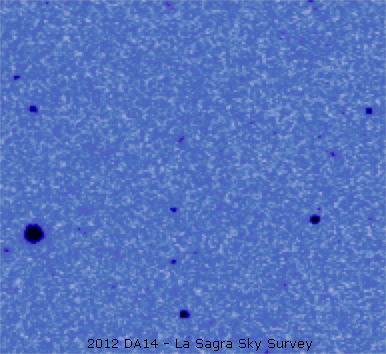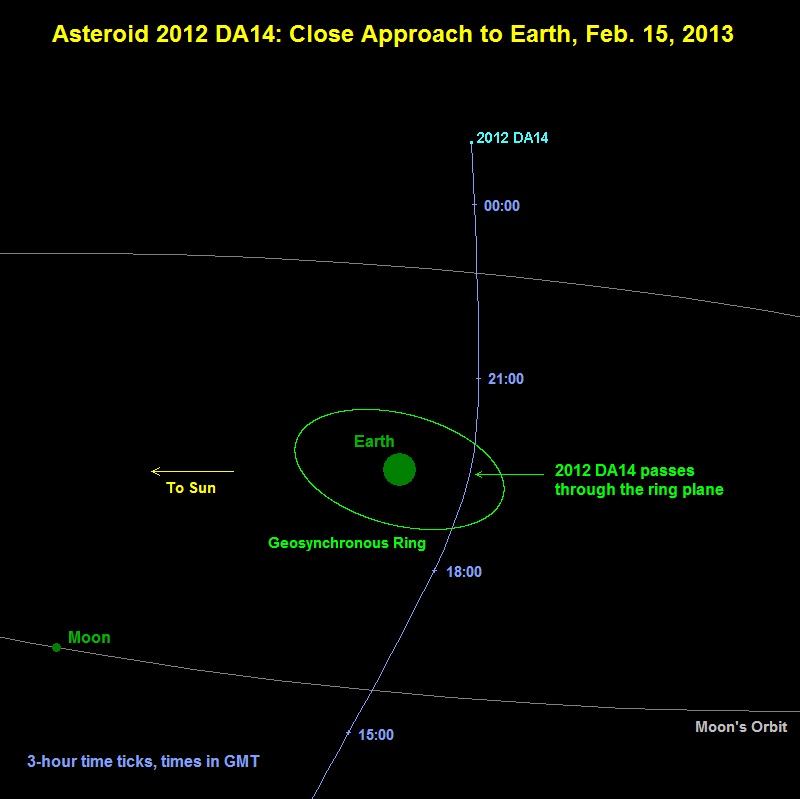The end of the world, valentine’s days and DA14
(Source: European Space Agency)
Doesn’t look like much, does it? A fuzzy image of a small fuzzy dot moving passed other fuzzy things.
But I’m getting ahead of myself.
Filmmakers love to produce movies about the end of the world. Armageddon, Deep Impact, Silent Running, etc. Usually it’s a huge asteroid on collision course or the Sun expanding into a Red Giant and swallowing the earth (in 5billion years, so we don’t have to worry so much about that!)
Whilst the “end” of the last Mayan calendar may have passed, it might seem that we’re not quite out of danger yet.
In fact we never will be. Some might say we should be. Were it not for the devastation of the dinosaurs by a massive impact then mammals may very not have had the chance afforded them and ultimately for humans to eventually evolve.
So what is likely to be the ultimate doom for the Earth?
Well here are some of the major ways current thinking for life on Earth to end.
A Supernovae happens on-average about once every 100,000 years per galaxy. And we are overdue one in the Milkyway!
Betelgeuse is such a star that will go supernova and very soon. It could already have happened and we might just not know it yet.
Within ~26 light years the explosion would sufficient to vaporise our atmosphere. At 640 light years away, we are far enough to Betelgeuse to enjoy the view without dying. Fortunately we are probably several billion years away from a star close enough to go supernova close enough…
Space isn’t empty. It looks cold and dark, but moving out there between stars are vast swathes of dust and gas bulldozing their way through the Milkyway. Left over from the formation of the galaxy and/or debris from novae long ago. One such dust cloud is the Coal Sack nebula. It’s huge, 60-70 light years across. Whilst we are some way away, we sometimes forgot that the Sun is moving around the galaxy at 200km/s. The Heliosphere, the sphere of energy and cosmic particles being thrown by the stellar wind are sufficient to keep normal interstellar dust from smothering the solar-system, but something as large as the Coal Sack would simply bulldozer its way thru the galaxy smothering the planets, blotting out the sun and in effect blotting out all the light and warm our sun grants. It would be a cold, slow death for our planet.
But of course we shouldn’t forget filmmakers favourite Death by Meteor.
Nasa tracks over 19000 man-made objects in orbit around the earth as well as around 10000 Near Earth Objects and further out via radar and the Deep Space Network many more objects and of course it’s remote Spacecraft and missions.
Remember that fuzzy dot on the fuzzy background at the start. Its name is DA14, or more correctly Asteroid 2012-DA14. On February 15th 2013 it will appear slightly clearer than a fuzzy dot. In fact it is going to pass so close to us that it pass between the Earth and the Moon. In fact closer than geostationary satellites.
Fortunately this time they have its trajectory plotted down to fine detail and we are not in danger. But it does remind us of the precariousness of life on our planet.
Something to remember this Valentine’s Day…


No comments:
Post a Comment